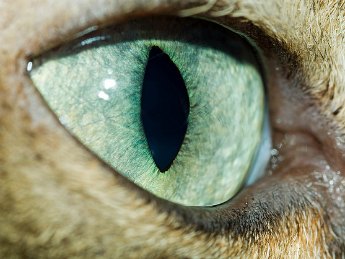The eyes of cats and dogs are quite similar to our own, but how are they different? The cat has the largest eyes of any meat eater; if our own eyes were proportionally the same, human eyes would be twenty centimetres across. But it goes beyond the looks-pun intended. In fact, the way our companion animals see influences how they interact with each other – and with us.
Field of Vision
Prey animals like rabbits can watch in two directions at once with eyes on each side of the head. But predators-dogs and cats – have eyes toward the front of the face that gives them depth perception and binocular vision so they can correctly time pursuit and pounce.
Most dogs have only about 30 to 60 degrees of binocular overlap versus approximately 140 degrees cats and humans. But dogs are champions when it comes to visual field of view. That means when Fido looks straight ahead he can still see 240 degrees, compared to 200 degrees in cats and 180 degrees in humans.
Seeing 20/20
Dogs cannot focus clearly on objects closer than about 25 centimetres (which explains why Fido may miss the two or three pieces of kibble left in his bowl). Cats are a bit better at near vision. But both dogs and cats rely more on motion rather than focus, and are rather farsighted, an evolutionary side effect of scanning the distance for prey. A dog can detect strong hand signals from as far away as 1.6 kilometres.
The visual acuity of dogs is about 20/75, although German shepherds, Rottweilers and Schnauzers appear to be even more near sighted. Cats have dogs beat with an average acuity between 20/100 and 20/200.
Glasses?
Contact lenses can correct nearsighted vision in dogs. That can be important especially for service animals or hunting dogs. But contacts are not practical when dogs lose them so easily. Dogs do benefit from being fitted with glasses. A veterinary ophthalmologist evaluates vision by refraction in the same way non-verbal children are examined. Products like Doggles.com are designed to fit the canine face in all its various shapes and sizes.
Low Light, High Light
Like human eyes, the dog’s iris to contract the pupil to a round pinpoint that limits the amount allowed inside. The feline eye is a more complex figure-eight muscle that closes to a slit much further than the canine eye.
Both cats and dogs have a tapetum lucidum, a layer of highly reflective cells behind the retina that reflects back any light the eye captures. That produces the eerie night-shine can be seen from your companion’s eyes and is why cats require only 1/6th the illumination level and use twice as much available light as people. Dogs’ eyes are about half as efficient as the cats’ but still better at using light than humans.
Colour Perception?
Both cats and dogs have fewer specialize cone cells on the retina able to distinguish colours than people do. But they can see colour.
Dogs seem to be similar to people who are “red-green color-blind.” Cats probably see more in terms of blue/green shades and appear able to tell the difference between colours that contrast. For cats, pattern and brightness are more important than colour. They can see colour but it does not matter to them.
Peripheral Vision
Cats are experts at seeing motion from the corners of their eyes. Cats also have a highly specialized ability to make extremely rapid eye movements, which allows them to better detect and follow an object, such as a mouse or even a feather on the end of a string toy. But dogs beat out cats on peripheral vision.
Both cats and dogs have a high density line of vision cells across the retina, called a visual streak. That lets them see sharp focused object at a distance even in the extremes of peripheral vision-out of the corners of their eyes. Cats and dogs tend to ignore stationary objects but this visual streak triggers their instinctive urge to chase whenever something moves in their peripheral vision.
The visual streak is most pronounced in long-nosed dogs-the breeds developed to hunt and chase. But many of the short-nosed dogs like Pugs do not have this visual streak. Instead, they have high density vision cells arranged in a single spot on the retina, called the area centralis. The area centralis has three times the density of nerve endings as the visual streak. That makes short-nose dogs much better able to see and react to human facial expressions – or watch TV.
Adapted from an article by Amy D Shojai




